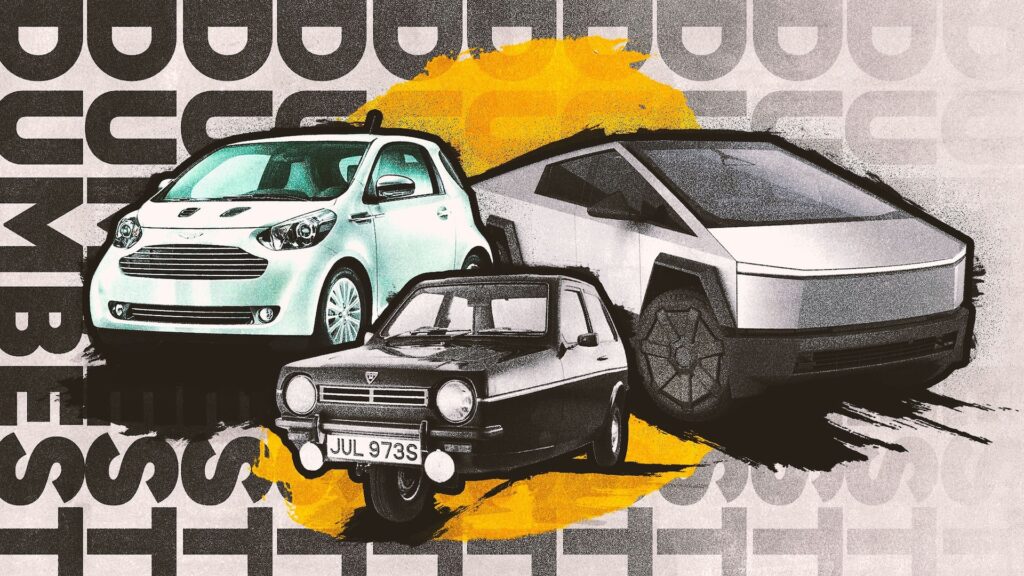Automobile enthusiasts often witness a curious mix of innovation and oddity in the automotive world. While some vehicles push boundaries with groundbreaking technology, others induce head-scratching with their perplexing designs and features. This article delves into some of the most perplexing vehicles that have left both critics and consumers questioning their existence.
Tesla Cybertruck
The Cybertruck by Tesla is a polarizing figure in the automotive landscape. Designed with sharp, angular lines, it has sparked debate more for its appearance than its capabilities. Although it boasts impressive performance figures, its unconventional design and concerns over reliability have garnered a significant amount of criticism. As noted by Scott Evans, “Cybertruck is up there, but it’s gotten slightly less dumb as Tesla has activated the rest of the feature set.”
Nissan Murano CrossCabriolet
In the realm of genre-bending vehicles, the Nissan Murano CrossCabriolet stands out, and not in a flattering way. While attempting to combine the SUV and convertible body styles, the CrossCabriolet ended up being criticized for its lack of structural integrity and practicality. Aaron Gold humorously noted, “You could feel the cowl shake just by getting into the car.”
Mazda MX-30
The Mazda MX-30 entered the electric SUV market with high hopes, but its limited range of just over 100 miles quickly made it an impractical choice for most consumers. Despite its engaging interior and handling, it was unable to compete against rivals offering significantly longer ranges, leading to its early discontinuation.
Toyota Mirai
Hailed as a hydrogen-powered marvel, the Toyota Mirai represented a vision of the future that never quite materialized. Despite its sleek design in its second generation, the decline of hydrogen refueling infrastructure has left the Mirai as a relic of what could have been. As Aaron Gold aptly commented, “Mirai is awesome if you don’t have anywhere to go.”
Honda CR-V FCEV
Honda’s foray into hydrogen with the CR-V FCEV offers limited electric-only range. Although it attempts to blend into the regular CR-V lineup, its hydrogen powertrain limits its practicality to regions with refueling stations, predominantly Southern California.
Aston Martin Cygnet
Badge engineering taken to an extreme, the Aston Martin Cygnet was essentially a Toyota iQ with a luxury badge. Designed to meet fuel economy standards, its high price tag did not deliver the luxury experience expected from the brand, leading Scott Evans to remark, “Talk about brand dilution.”
2025 Mercedes-Benz G-Class
The Mercedes-Benz G-Class often sparks debate due to its high price and luxury styling, despite being a vehicle initially designed for off-road prowess. Its presence in urban environments over its intended rugged terrains makes it an intriguing yet arguably impractical choice for many buyers.
Chevrolet SSR
The Chevrolet SSR combined the aesthetics of a convertible with the form of a pickup truck, but failed to deliver on utility. Despite its unique design and cult following, its lack of practical features made it more of a novelty than a necessity.
Reliant Robin
The Reliant Robin is infamous for its three-wheel design, leading to significant stability issues. Its notoriety was further boosted by comedic stunts on Top Gear, cementing its status as a cautionary tale in automotive design.
Chrysler TC by Maserati
An ill-fated collaboration, the Chrysler TC by Maserati attempted to blend American and Italian automotive elements with little success. Its high production costs and underwhelming performance made it an impractical choice, despite its niche appeal to some car enthusiasts.
Original Story at www.motortrend.com
